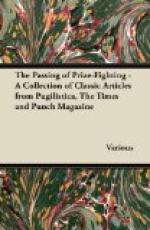We had strong hopes for a time that The Meat Trade Review would find him. Timon is fond of raw meat. But failure again resulted. We have now reached Syren and Shipping and The Ironmongers’ Gazette and—
* * * * *
I must stop here to inform you of the glad news. Elaine has just hurried in to tell me that Timon has replied and will be back to-morrow.
How did we catch his eye? Well, of course we should have thought of it before. It was The Post Office Gazette.
* * * * *
The romance of bookmaking.
A visit to Messrs. Pryce UNLTD.
(With acknowledgments in the right quarter.)
A gigantic commissionaire flings wide the doors for us and, passing reverently inside, we are confronted by the magnificent equestrian statue of Mr. Bookham Pryce, the founder of the firm. This masterpiece of the Post-Cubist School was originally entitled, “Niobe Weeping for her Children,” but the gifted artist, in recognition of Mr. Pryce’s princely offer of one thousand guineas for the group, waived his right to the title.
On the left we see the Foreign Department. Here we watch with rapt attention the arrival of countless business telegrams from all parts of the world. We choose one or two at random and see for ourselves the ramifications of Pryce’s far-flung booking service. This one from China: “Puttee fifty taels Boko Lanchester Cup;” another from distant Siberia, emerging from the primeval forests of that wondrous land of the future: “Tenbobski Quitter Ebury Handicap.” Bets are accepted in all denominations from Victory Bonds to the cowrie-shells of West Africa.
Passing up the marble staircase and leaving the Home Department on our right we arrive at the Stumer Section. Here a small army of ex-Scotland Yard detectives are engaged in dealing with mala-fide commissions— attempts on the part of men of straw to make credit bets, or telegrams despatched after a race is over.
Where shall we go next? We ask a courteous shopwalker, who in flawless English advises us to try the Winter Gardens, where a delightful tea is served at a minimum cost. Here, whilst sipping a fragrant cup of Orange Pekoe, we can watch the large screen, on which the results of all races are flashed within ten seconds of the horses passing the winning-post. At one time, in fact, it was nothing unusual for Pryce’s to have the results posted before the horses had completed the course, but in deference to the prejudices of certain purists this practice was abandoned.
Follows a hurried visit to the Library and Museum, where we gaze enthralled at the original pair of pigeon-blue trousers with which Mr. Bookham Pryce made his sensational debut on the Lincoln course in the spring of 1894. We might linger here a moment to muse over the simple beginnings of great men, but time is pressing and we are all agog to visit the Bargain Basement.




